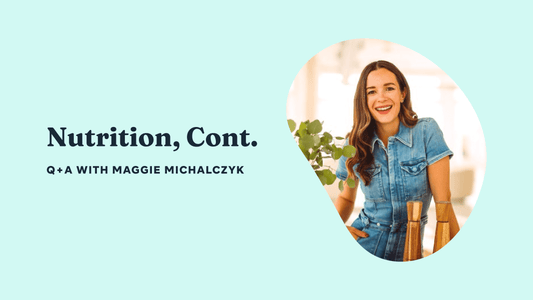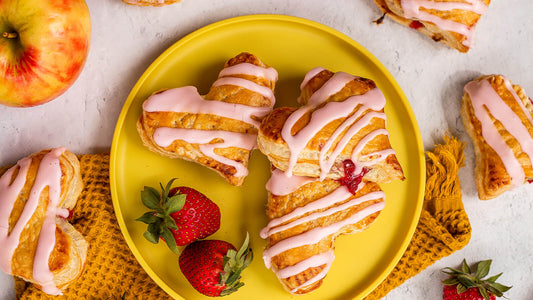Are you a parent on the go? Food photographer? Meal prepper extraordinaire? Even if your answer is "D, none of the above," you've likely cut up an apple and left it out, only to find that the slices turned brown.
While there is nothing wrong with eating a browned apple slice, we know it's not everyone's cup of tea. Whether you're preserving your apples for a photoshoot or have a picky eater who won't touch a sliced apple unless it's in pristine condition, we have a few tips and tricks for you to follow to keep those apples looking as fresh as they taste.
Recently, the Yes! Apples team tested five methods to prevent apples from browning. We soaked apple slices in five different solutions: plain water, lemon water, citric acid, honey water, and lemon-lime soda. Follow along below to learn what we tried and which method is our favorite!
Wait...Why Do Apples Brown?!
As with most fruit, apples are composed of several different parts, each with their own purpose and nutritional benefit. Let's peel back the apple skin and dig into the flesh of the matter. The pulp (another term for flesh) is what most people are used to baking with. It contains more Vitamin C and the apple’s pectin, a starch naturally present in most fruits that provides structure and helps jams set when heated.
When the pulp is exposed to oxygen, a biochemical process called enzymatic browning begins. The creamy white flesh is oxidized by polyphenol oxidase (PPO), an enzyme that does just what its name implies: oxidizes polyphenols, which are a category of compounds found in plants. A chain reaction occurs in which the newly formed chemical product of the oxidation reacts with the apple's amino acids, producing brown melanin (you heard that right—these are the same pigments that cause varying colors of flesh in humans, too!).
But, why do some apples brown more slowly than others? You may remember that our resident "flavorologist," Chef Caroline Fey, undertook the task of tasting all of the Yes! Apples varieties and discovered that varieties like Empire, EverCrisp®, Ginger Gold, and Pink Lady are slower to brown.
Enzymatic browning occurs at different rates, depending on the amount of initial enzyme and polyphenols present in the chemical reaction.
The Process
Materials
- 6 Gala apples, each cut into 8 slices
- 6 clear plastic snack bags with zip closures
- Tap water, brought to room temperature (we measured at 72º F)
- 1 lemon
- 1 tsp King Arthur Citric Acid
- 16 oz. lemon-lime soda
- 2 Tbsp honey
To eliminate as much bias as possible, we used Gala apples for all trials. Each apple was cut into eight slices, between ½ in. to ¾ in. in thickness. We chose Gala for this experiment because its flesh is of medium firmness and the variety is best used in its raw form, like for snacking or in salads.
We tested the five soaking methods against a control in which we left plain, untreated Gala slices in a ziplock bag for 8 hours. We left all of the tests at room temperature, but adding refrigeration will slow the release of ethylene, which causes apples to ripen faster. Tip: If you're trying this experiment at home and would like to test room temperature vs. refrigeration, double all of the above materials!
Each treatment was applied for 5 minutes in a non-reactive ceramic bowl, after which time the apples were lightly rinsed with tap water and patted dry to remove as much excess treatment as possible. We began this experiment in the morning and checked back 8 hours later, which is the average length of a work day or a school day (plus an after-school activity!). This experiment is meant to result in the most practical application for everyday use.
The Results
Apples treated in the honey and water solution browned the least over the 8 hours, but apples soaked in plain water were a close second. Ultimately, your preference depends on what materials you have on hand and what the apples will be used for (i.e., how much brown can you tolerate?).
6th Place: Control Group
Setup: 8 Gala slices in a sealed zip-top bag
The apples left at room temperature in a zip-top bag for 8 hours browned the most. These apples started browning within the first 15 minutes. Unless you plan to snack or cook right away, we do not recommend this method!
5th Place: Lemon Water
Setup: 8 Gala slices soaked in the juice of 1 lemon (2-3 Tbsp) + 2 cups water for 5 minutes, then rinsed, patted dry, and stored in a zip-top bag
These apples started to brown during the third hour of the experiment. While this method dilutes the sour lemon flavor (vs. squeezing lemon juice directly on the apples), it doesn't do much to preserve the apples for later use.
4th Place: Citric Acid
Setup: 8 Gala slices sprinkled with 1 tsp citric acid and left to sit for 5 minutes, then rinsed, patted dry, and stored in a zip-top bag
Citric acid might not be in your pantry at the moment, but it isn't too hard to find! Hesitant about buying a container just for this experiment? Here are some ways you can put it to good use in and around the kitchen.
If you're a food photographer, this method is for you. The citric acid kept the apple flesh pristine visually—and who doesn't love the look of a fresh, crisp apple? However, unless you love the tart flavor of sour candy, this one may not be for you. Even after 8 full hours, the apples had a tang that might be off-putting to some. Tip: If you're running this experiment at home, try leaving the citric acid on the apples for a shorter amount of time.
3rd Place: Lemon-Lime Soda
Setup: 8 Gala slices soaked in 16 oz. of lemon-lime soda for 5 minutes, then rinsed, patted dry, and stored in a zip-top bag
If you have a can of soda on hand, this is a quick and easy method to keep apples from browning. A key component of lemon-lime soda is citric acid, which we now know will inhibit browning. Since there is also sugar in soda, the flavor imparted is much more mellow. An additional anti-browning property of lemon-lime soda? Sodium chloride (otherwise known as salt). The chloride ions in salt inhibit those PPO enzymes we discussed earlier and slow the oxidation process.
2nd Place: Plain Water
Setup: 8 Gala slices soaked in 2 cups of water for 5 minutes, then drained, patted dry, and stored in a zip-top bag
This method isn't new—some recipes will have you soak apple slices in water before baking into a pie, so there must be a reason behind this extra step! Cheap and easy to access, room-temperature tap water might be our favorite way to reduce browning. A quick soak in the morning can result in a crunchy, perfect apple slice at lunchtime—and if your kids won't touch an apple that's only tinged with the slightest hint of brown, you know this is a lifesaver!
1st Place: Honey Water
Setup: 8 Gala slices soaked in 2 Tbsp honey + 2 cups of water for 5 minutes, then rinsed, patted dry, and stored in a zip-top bag
Adding sugar to the anti-browning solution blocks exposure to oxygen. This method not only kept the apples from browning on an aesthetic level, but also retained the integrity of the apple flavor beyond the 8 hours we tested. If you have honey on hand, as most households do, this method is the winner!
Conclusion
While different results may come in handy for different applications, our favorite (and the cheapest!) anti-browning method is to soak apples in plain water. When we want those slices to be a little whiter and brighter (while retaining the apple's flavor), we'll use the honey water method.
Try this out at home and let us know what you think!
Sources
Du, Joy. “Delaying Enzymatic Browning Reaction in Gala Apples.” The Expedition 11 (September 16, 2021).
“Why Do Sliced Apples Turn Brown?” Encyclopædia Britannica. Accessed May 17, 2023. https://www.britannica.com/story/why-do-sliced-apples-turn-brown.





